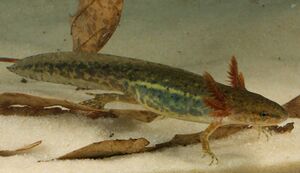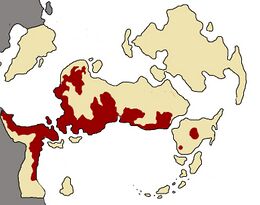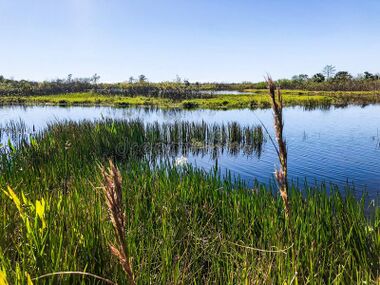Ambystoma bardus
| Striped Axolotl | |
|---|---|

| |
| Ambystoma bardus | |
| Scientific classification | |
| Kingdom: | Animalia
|
| Phylum: | Chordata
|
| Class: | Amphibia
|
| Order: | Caudata
|
| Family: | Ambystomatidae
|
| Genus: | Ambystoma
|
| Species: | A. bardus
|
| Binomial name | |
| Ambystoma bardus Lapenter, 1922
| |

| |
| Range of A. bardus in Inyursta | |
Ambystoma bardus, the Striped axolotl, is a species of fully-aquatic mole salamander native to Inyursta, Gran Cuscatlan, and other nations along the Sea of Juarez. It is also known as the Pésacoja-petí by locals. Striped axolotls are common in the pet trade, and often poached and sold into captivity due to their vibrant colors and easy keeping requirements.
Species Characteristics
Physical Description
The Striped axolotl is a small species, reaching only 15.5cm (6.1in) total length (TL) at most. Their tails remain tall and paddle-like into adulthood. Heads are also atypically small for a neotenic ambystoma species, making up less than 8% TL.
As their name suggests, the defining feature of this species is a broken but well-visible stripe running down either side, usually yellow or white in contrast with the gray, brown or olive color of the rest of the body. Also present are a number of dark spots on the tail. The colors and contrast of this stripe, as well as the visibility of the tail spots vary based upon geographic locality.
Life History
Like other "axolotls" and the closely related Common river salamander, Striped axolotls are completely neotenic, meaning that they retain their larval characteristics, such as gills, webbed feet and a paddle-like tail, throughout adulthood. Unlike similar species, the heads of A. bardus do not enlarge as drastically when they reach sexual maturity.
Breeding occurs in shallow, heavily vegetated wetlands laying long clumps of eggs near the shore. Larval Striped axolotls hide in the vegetation and fallen leaf litter for the first two years of their lives, before venturing out into deeper waters. Ambystoma bardus' is capable of both parthenogenesis (asexual reproduction) and kleptogenesis ("sperm stealing"). Predators include large fish, semi-aquatic snakes and large frogs. Where their ranges overlap, the closely-related, though larger and more voracious Common river salamander is also known to eat Striped axolotls (especially larvae). Prey includes small minnows and invertebrates such as insect larvae and worms. Striped axolotls are primarily nocturnal predators, emerging from vegetation and holes in the substrate around sunset.
Habitat
This species is found in most permanent, shallow, freshwater wetlands within its range. Suitable habitats include smaller oxbow lakes (or the vegetated fringes of larger lakes), Llanos wet prairie, rainforest and tropical woodland depressional swamps, and fresh-interior coastal marsh. In southern Marindo they have been found occupying brackish water as saline as 1.85 parts-per-thousand.
Preferred microhabitats are moderate-visibility pools typically 2-4m in depth. Vegetation associated with higher population densities are broad-leafed plants of the genus Philodendron and sedges of the genera Carex and Machaerina. Larval individuals are also strongly associated with the common Sago pondweed (Stuckenia pectinata) and Inyurstan River moss (Taxiphyllum ripaceae). Dissolved oxygen levels of 2.0mg/l or higher are necessary for respiration, while pH levels of 5.6 - 7.9 can are ideal.
Individuals have been found in the San Ignaçio Botanical Gardens, artificial ponds outside of Guadalojas, and other new or non-historical ponds since 1980. Herpetologists Sant-Yves & Aristide (2017) proposed the hypothesis that this species possess a cryptic terrestrial morph that allows it to occupy wetlands separated by land; while DePolon et al. (2019), as part of a larger study on tropical wetland succession & restoration, hypothesized that this species eggs remain viable and dormant in non-submerged (albeit still moist) scenarios, allowing zoonotic transport between wetlands.
In Captivity
Striped axolotls are a commonly exported species in the pet trade. Their vibrant colors, including the namesake "stripe" and bright red gills, small size, easy water requirements and "exotic" nature make them a desirable and popular pet. Ideal set-ups include at least a 15-20gallon tank or higher with a large number of live plants. Filtration and temperature values are less important, making them easier to keep for beginners. In captivity, Striped axolotls will take bloodworms and dried brine shrimp. Adults should not be kept with small fish such as guppies or tetras, as they will likely attempt to eat their tank mates. Under proper conditions, this species can live up to 12 years in captivity.
A special permit with the Inyurstan Department of Wildlife (IDW) is required to legally capture and export this species. Collection is also banned from all nationally-owned parks & preserves, while the provincial governments of Marindino Centrèle and Costa Arseilles have also banned collecting of this species.
Conservation Threats
Poaching and overharvesting are considered to be a pressing threat to the survival of this species in the wild. Because adults are cryptic and often live in water higher than waist-deep, while juveniles are small and hard to find, collectors often simply harvest egg masses by the hundreds. Sites subject to high numbers of collectors - especially unique geographic phenotypes and color morphs - then start to struggle with offspring recruitment due to the egg harvesting.
Agricultural expansion also erodes wetland habitat. Overgrazing by cattle reduces the pond-edge vegetation in areas with fluctuating water levels which depletes both refugia and prey abundance (more plants = more invertebrate prey). Run-off from fertilizers causes harmful algal blooms which are both toxic and rapidly deplete dissolved oxygen levels.
See Also
Related Species
Common River salamander (Ambystoma puerfluminus)
Marindinoan Black mole salamander (Ambystoma articolor)
Sierran Black mole salamader (Ambystoma sanjuaniensis)
Cuscatlani axolotl (Ambystoma crassusei)
Inyurstan Species Lists
Inyurstan Herpetofaunal Checklist
Species Endemic to Inyursta
Relevant Scientists
Juan-Jerome Lapenter - Described the species
Dr. Marina Sant-Yves - Lead researcher of post-2010 genetics analysis & 2017 dispersion hypothesis.
Lorenzo de Matto - Inyurstan Department of Wildlife (IDW) District Biologist III amphibian specialist
